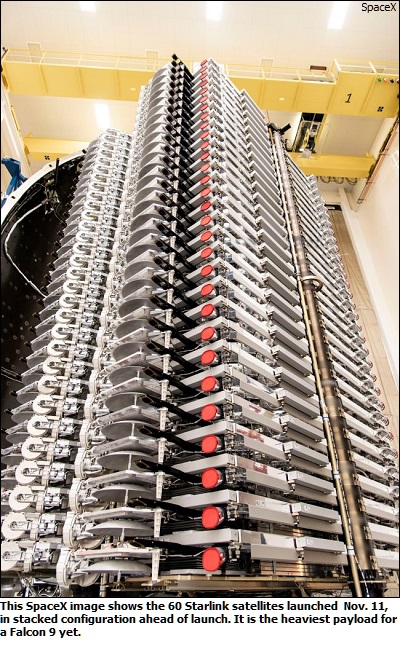
|
|

|
|
| April 25, 2024 |
|
SpaceX launched 60 Starlink satellites 
CAPE CANAVERAL, FL - SpaceX's plans to bring global internet coverage to the world just took another leap forward as its 9th Falcon 9 rocket flight of the year launched 60 new Starlink internet satellites into orbit Monday (Nov. 11).
The satellites rode into space atop a veteran Falcon 9 first stage, ending a nearly three-month launch hiatus for the company. The last time a SpaceX Falcon 9 took to the skies, was on Aug. 6, when the company’s flagship rocket carried the Israeli AMOS-17 communications satellite into space. The sooty Falcon roared to life at 9:56 a.m. EST (1456 GMT), lifting off from Space Launch Complex 40 at Cape Canaveral Air Force Station here in Florida, marking the fourth flight for this particular booster, and the first time a Falcon 9 has flown more than three times. "The Falcon has landed for the fourth time," SpaceX Starlink engineer Lauren Lyons, said during launch commentary. "These boosters are designed to be used 10 times. Let's turn it around for a fifth, guys." The launch occurred on Veterans Day, a U.S. holiday commemorating military veterans, and SpaceX dedicated the flight to service members. "Liftoff! With gratitude to our veterans today and always," a SpaceX commentator said. "Go, U.S.A.!" Following the successful launch, the rocket's first stage gently touched down on a SpaceX's drone ship landing platform "Of Course I Still Love You" in the Atlantic Ocean, marking the company's 45th booster recovery. Tucked inside the rocket's nose cone were 60 Starlink satellites, the second batch (and first operational set) of SpaceXs broadband internet megaconstellation, which the company hopes will help provide affordable internet coverage to the world. Increased connectivity Currently, internet users rely on wireless cell towers or cables routed into our homes and offices to access the internet. This means that many rural, remote areas around the world are often left without access as the satellites providing coverage are too far away. Many other options for satellite-based internet exist, but can be very expensive and offer slow connecting rates. SpaceX wants to change that. "This will not only provide internet access to areas that don't have it, but provide competitive access to areas that already have connectivity,” company CEO, Elon Musk said in a media teleconference prior to the first Starlink launch in May. Traditional satellite internet providers beam internet coverage down from a high orbital perch, with their satellites stationed in what’s known as geostationary orbit (which is typically 22,000 miles above the Earth). Because the signal has to travel such a long distance, the time it takes to send and receive data is substantially longer and more akin to the days of dial-up. By operating at a lower altitude, approximately 217 miles (350 km) above the Earth, SpaceX hopes to cut down on this issue and provide reliable coverage at an affordable price. And SpaceX is not alone. Several other companies (including OneWeb, TeleSat, and now Amazon) want to provide internet to the masses by deploying a network of small satellites in low-Earth orbit, hovering much closer to the Earth than current satellites. Last month, Musk tweeted via Starlink for the first time. And with as few as six to eight more launches, the company says it could begin offering broadband service in the United States by mid-2020. “We still have a long way to go from tweets to 4K videos, but we are on our way,” company representatives said during Monday’s launch broadcast. Astronomical impact But not everyone is thrilled about SpaceX’s new business venture. Many astronomers are concerned that mega constellations, like Starlink, will impede their research and make it more difficult for amateur astronomers to enjoy the night sky. When the first batch of satellites launched in May, they were bright enough to see without a telescope as they were easily visible, marching across the sky like a train shortly after launch. Astronomers feared the satellites, which appear as bright as stars, would make it harder to distinguish between the two in the night sky. SpaceX and Musk, tried to reassure concerned astronomers that once the satellites settled into place, they would be less noticeable. Astronomers are anxiously waiting to see what happens with this second batch of satellites and how bright they will appear once they’ve reached their intended orbit. (Source: Space.com) Story Date: November 12, 2019
|